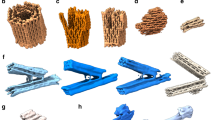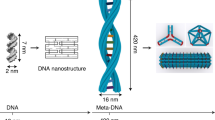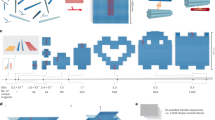A 1.7-kilobase single-stranded DNA that folds into a nanoscale octahedron (original) (raw)
- Letter
- Published: 12 February 2004
Nature volume 427, pages 618–621 (2004)Cite this article
- 10k Accesses
- 32 Altmetric
- Metrics details
Abstract
Molecular self-assembly offers a means of spontaneously forming complex and well-defined structures from simple components. The specific bonding between DNA base pairs has been used in this way to create DNA-based nanostructures and to direct the assembly of material on the subnanometre to micrometre scale1,2. In principle, large-scale clonal production of suitable DNA sequences and the directed evolution of sequence lineages towards optimized behaviour3 can be realized through exponential DNA amplification by polymerases. But known examples of three-dimensional geometric DNA objects4,5,6 are not amenable to cloning because they contain topologies that prevent copying by polymerases1,2,7. Here we report the design and synthesis of a 1,669-nucleotide, single-stranded DNA molecule that is readily amplified by polymerases and that, in the presence of five 40-mer synthetic oligodeoxynucleotides, folds into an octahedron structure by a simple denaturation–renaturation procedure. We use cryo-electron microscopy to show that the DNA strands fold successfully, with 12 struts or edges joined at six four-way junctions to form hollow octahedra approximately 22 nanometres in diameter. Because the base-pair sequence of individual struts is not repeated in a given octahedron8,9, each strut is uniquely addressable by the appropriate sequence-specific DNA binder.
This is a preview of subscription content, access via your institution
Access options
Subscribe to this journal
Receive 51 print issues and online access
$199.00 per year
only $3.90 per issue
Buy this article
- Purchase on SpringerLink
- Instant access to full article PDF
Prices may be subject to local taxes which are calculated during checkout
Additional access options:
Similar content being viewed by others


Meta-DNA structures
Article 07 September 2020

References
- Seeman, N. C. DNA in a material world. Nature 421, 427–431 (2003)
Article MathSciNet ADS Google Scholar - Seeman, N. C. DNA nanotechnology: novel DNA constructions. Annu. Rev. Biophys. Biomol. Struct. 27, 225–248 (1998)
Article CAS Google Scholar - Wilson, D. S. & Szostak, J. W. In vitro selection of functional nucleic acids. Annu. Rev. Biochem. 68, 611–647 (1999)
Article CAS Google Scholar - Chen, J. H. & Seeman, N. C. Synthesis from DNA of a molecule with the connectivity of a cube. Nature 350, 631–633 (1991)
Article CAS ADS Google Scholar - Zhang, Y. & Seeman, N. C. The construction of a DNA truncated octahedron. J. Am. Chem. Soc. 116, 1661–1669 (1994)
Article CAS Google Scholar - Dorenbeck, A. . DNA Nanostructures by Self-Assembly of Trisoligonucleotidyls. Thesis, Univ. Bochum (2000)
Google Scholar - Seeman, N. C. Construction of three-dimensional stick figures from branched DNA. DNA Cell Biol. 10, 475–486 (1991)
Article CAS Google Scholar - Seeman, N. C. Nucleic-acid junctions and lattices. J. Theor. Biol. 99, 237–247 (1982)
Article CAS Google Scholar - Seeman, N. C. De novo design of sequences for nucleic acid structural engineering. J. Biomol. Struct. Dyn. 8, 573–581 (1990)
Article CAS Google Scholar - Li, X. J., Yang, X. P., Qi, J. & Seeman, N. C. Antiparallel DNA double crossover molecules as components for nanoconstruction. J. Am. Chem. Soc. 118, 6131–6140 (1996)
Article CAS Google Scholar - Larson, S. B. et al. Double-helical RNA in satellite tobacco mosaic virus. Nature 361, 179–182 (1993)
Article CAS ADS Google Scholar - Tang, L. et al. The structure of Pariocoto virus reveals a dodecahedral cage of duplex DNA. Nature Struct. Biol. 8, 77–83 (2001)
Article CAS Google Scholar - Zhang, X., Yan, H., Shen, Z. & Seeman, N. C. Paranemic cohesion of topologically-closed DNA molecules. J. Am. Chem. Soc. 124, 12940–12941 (2002)
Article CAS Google Scholar - Sa-Ardyen, P., Vologodskii, A. V. & Seeman, N. C. The flexibility of DNA double crossover molecules. Biophys. J. 84, 3829–3837 (2003)
Article CAS Google Scholar - Dubochet, J. et al. Cryo-electron microscopy of vitrified specimens. Q. Rev. Biophys. 21, 129–228 (1988)
Article CAS Google Scholar - Frank, J. Averaging of low exposure electron micrographs of non-periodic objects. Ultramicroscopy 1, 159–162 (1975)
Article CAS Google Scholar - Frank, J. Classification of macromolecular assemblies studied as ‘single particles’. Q. Rev. Biophys. 23, 281–329 (1990)
Article CAS Google Scholar - Seeman, N. C. & Kallenbach, N. R. Design of immobile nucleic acid junctions. Biophys. J. 44, 201–209 (1983)
Article CAS Google Scholar - Zuker, M. Mfold web server for nucleic acid folding and hybridization prediction. Nucleic Acids Res. 31, 1–10 (2003)
Article Google Scholar - Stemmer, W. P., Crameri, A., Ha, K. D., Brennan, T. M. & Heyneker, H. L. Single-step assembly of a gene and entire plasmid from large numbers of oligodeoxyribonucleotides. Gene 64, 49–53 (1995)
Article Google Scholar - Carragher, B. et al. Leginon: an automated system for acquisition of images from vitreous ice specimens. J. Struct. Biol. 132, 33–45 (2000)
Article CAS Google Scholar - Ludtke, S. J., Baldwin, P. R. & Chiu, W. EMAN: semiautomated software for high-resolution single-particle reconstructions. J. Struct. Biol. 128, 82–97 (1999)
Article CAS Google Scholar - Huang, C. C., Couch, G. S., Pettersen, E. F. & Ferrin, T. E. Chimera: An extensible molecular modeling application constructed using standard components. Pacif. Symp. Biocomput. 1, 724 (1996)
Google Scholar
Acknowledgements
We thank F. Guerra for help with EMAN reconstructions and B. Carragher, R. Milligan and C. Potter for advice on reconstructions. This work was supported by the National Aeronautics and Space Administration and The Skaggs Institute for Chemical Biology at The Scripps Research Institute. Some of the work presented here was conducted at the National Resource for Automated Molecular Microscopy, which is supported by the National Institutes of Health through the National Center for Research Resources. W.M.S. is a Fellow supported by the Damon Runyon Cancer Research Foundation. Molecular graphics images were produced using the UCSF Chimera package.
Author information
Authors and Affiliations
- Departments of Chemistry and Molecular Biology and The Skaggs Institute for Chemical Biology, The Scripps Research Institute, 10550 North Torrey Pines Road, La Jolla, California, 92037, USA
William M. Shih & Gerald F. Joyce - Department of Cell Biology, The Scripps Research Institute, 10550 North Torrey Pines Road, La Jolla, California, 92037, USA
Joel D. Quispe
Authors
- William M. Shih
You can also search for this author inPubMed Google Scholar - Joel D. Quispe
You can also search for this author inPubMed Google Scholar - Gerald F. Joyce
You can also search for this author inPubMed Google Scholar
Corresponding author
Correspondence toWilliam M. Shih.
Ethics declarations
Competing interests
The authors declare that they have no competing financial interests.
Supplementary information
Rights and permissions
About this article
Cite this article
Shih, W., Quispe, J. & Joyce, G. A 1.7-kilobase single-stranded DNA that folds into a nanoscale octahedron.Nature 427, 618–621 (2004). https://doi.org/10.1038/nature02307
- Received: 08 October 2003
- Accepted: 18 December 2003
- Issue Date: 12 February 2004
- DOI: https://doi.org/10.1038/nature02307